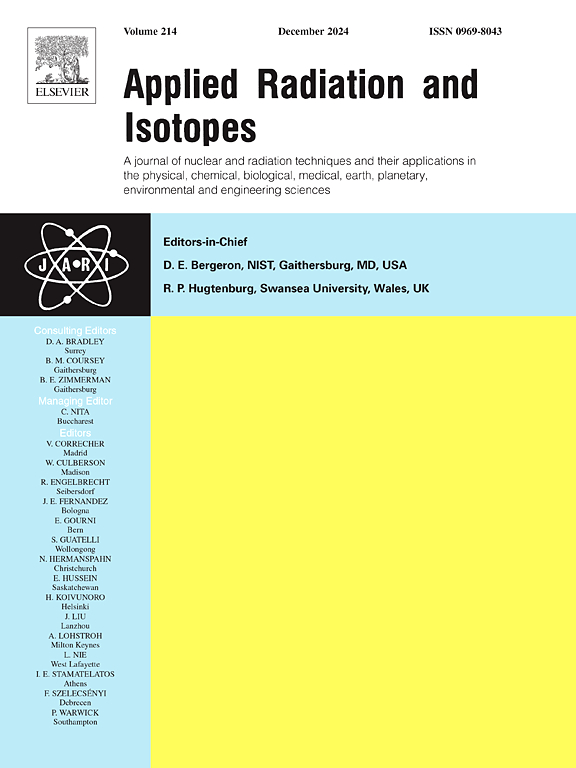Impact of dose and heating rate on thermoluminescence kinetics in aquamarine (Be3Al2(SiO3)6:Fe)
IF 1.8
3区 工程技术
Q3 CHEMISTRY, INORGANIC & NUCLEAR
引用次数: 0
Abstract
The study of a thermoluminescent (TL) material begins with the response of the material to different doses of radiation and different rates of heating (Bos, 2006a), For this reason, the present work deals with the possible variations of the kinetic parameters for two groups of glow curves of beryl in its variety known as aquamarine. (Be3Al2(SiO3)6: Fe). The exposure and reading process was performed in a RISO TL/OSL DA-20 reader at room temperature. For the development of this work, the sample was irradiated at different doses (Between 4 and 100 Gy) of β-radiation with a source of 90Sr/90Y. The glow curve was recorded at a heating rate of 1 °C/s. The results show four experimental glow peaks around the 75, 115, 189 y 302 °C. The glow peak with the highest intensity at about 75 °C is referred to as the "main peak". A second set of glow curves was obtained with a radiation dose β of 1 Gy. These were recorded at different heating rates between 0.5 and 5 °C/s. The glow peaks show a shift towards higher temperature values as the heating rate increases, in agreement with theory. However, a slight decrease in the area of the glow peak is observed, more pronounced in the case of the main peak. The kinetic analysis performed on the glow curves recorded at different doses of beta radiation and heating rates, using different methods of kinetic theory, such as the initial ascent method, full peak glow, curve fitting and the dimensionless fitting method, shows that the trapping parameters (activation energy, frequency factor, and order parameter) are independent of the absorbed dose, in the measured range, and of the heating rate used.
剂量和加热速率对海蓝宝石(Be3Al2(SiO3)6:Fe)热发光动力学的影响。
对热发光(TL)材料的研究始于该材料对不同辐射剂量和不同加热速率的反应(Bos,2006a),因此,本研究涉及被称为海蓝宝石的绿柱石的两组发光曲线的动力学参数的可能变化。(Be3Al2(SiO3)6: Fe)。曝光和读取过程在室温下的 RISO TL/OSL DA-20 读取器中进行。为了完成这项工作,样品在不同剂量(4 至 100 Gy)的 β 辐射下,用 90Sr/90Y 源进行辐照。以 1 °C/s 的加热速率记录辉光曲线。结果显示,在 75、115、189 y 302 °C 附近有四个实验辉光峰。在 75 °C 左右强度最高的辉光峰被称为 "主峰"。第二组辉光曲线是在辐射剂量 β 为 1 Gy 时获得的。这些曲线是在 0.5 至 5 °C/s 的不同加热速率下记录的。随着加热速率的增加,辉光峰值显示出向更高温度值的移动,这与理论相符。不过,辉光峰的面积略有减小,主峰的情况更为明显。使用不同的动力学理论方法,如初始上升法、全峰辉光、曲线拟合和无量纲拟合法,对不同剂量的β辐射和加热速率下记录的辉光曲线进行的动力学分析表明,在测量范围内,俘获参数(活化能、频率因子和阶次参数)与吸收剂量和所使用的加热速率无关。
本文章由计算机程序翻译,如有差异,请以英文原文为准。
求助全文
约1分钟内获得全文
求助全文
来源期刊

Applied Radiation and Isotopes
工程技术-核科学技术
CiteScore
3.00
自引率
12.50%
发文量
406
审稿时长
13.5 months
期刊介绍:
Applied Radiation and Isotopes provides a high quality medium for the publication of substantial, original and scientific and technological papers on the development and peaceful application of nuclear, radiation and radionuclide techniques in chemistry, physics, biochemistry, biology, medicine, security, engineering and in the earth, planetary and environmental sciences, all including dosimetry. Nuclear techniques are defined in the broadest sense and both experimental and theoretical papers are welcome. They include the development and use of α- and β-particles, X-rays and γ-rays, neutrons and other nuclear particles and radiations from all sources, including radionuclides, synchrotron sources, cyclotrons and reactors and from the natural environment.
The journal aims to publish papers with significance to an international audience, containing substantial novelty and scientific impact. The Editors reserve the rights to reject, with or without external review, papers that do not meet these criteria.
Papers dealing with radiation processing, i.e., where radiation is used to bring about a biological, chemical or physical change in a material, should be directed to our sister journal Radiation Physics and Chemistry.
 求助内容:
求助内容: 应助结果提醒方式:
应助结果提醒方式:


